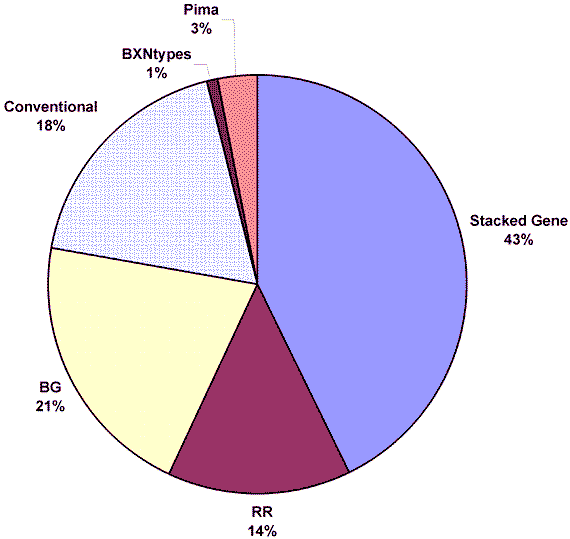![]()
Update on the 2002 Arizona Cotton Crop
by Jeffrey C. Silvertooth,
Extension Agronomist, Professor & Head, SWES
According to recent USDA reports, 238,000 acres have been planted to cotton in Arizona in 2002. This represents a decline of ~20.3% in Upland (to 230,000) and ~3.8% in Pima (to 8,000) compared to 2001. The same USDA reports indicate that ~14.4 million acres have been planted to cotton in the U.S. in 2002, which is 8.6% less than 2001. Considering the recent cotton markets and the overall agricultural economy, that still is a lot of cotton acreage in the U.S. and a testimony to the resiliency of the cotton industry. The recent passage of the new U.S. Farm Bill has certainly had an impact on the acres planted to cotton as well.
Figure 1 provides a breakdown in the percentages of the various variety types that have been planted in Arizona in 2002. Approximately 82% of the 2002 Arizona crop is planted to transgenic varieties. I am continually impressed by the rapid introduction of this technology into Arizona and the entire U.S. cotton industry since its first commercial introduction in 1995. The numbers of varieties that are available with various transgenic packages are proliferating at an incredible rate. This reinforces the importance of maintaining a familiarity of the varieties that are available, including their growth and development characteristics before using them to any large extent. It is difficult to gain a full appreciation of a plant variety's "personality" until you have a chance to work with it firsthand and evaluate it under various soil, environment, and management conditions. However, a good opportunity to review variety performance is available in every cotton-producing county in Arizona through the University of Arizona (UA) Commercial Variety Testing Program. This program is managed in each county by the local UA Agricultural Extension Agent in cooperation with a grower-cooperator in representative areas. Some counties have several variety testing locations to evaluate their performance under various conditions. I encourage you to contact the Extension Agent in your county for information regarding the location, varieties included, and basic management parameters (planting date, population, soil type, etc.) for the variety tests in your area.
The 2002 Arizona crop is developing very well, at least at this time. Overall, fruit retention levels have been very high across the State, and progress through the fruiting cycle has been right on track in relation to expected benchmarks associated with heat unit accumulations after planting (HUAP, 86/55 oF thresholds). The hot and dry conditions have actually been conducive to good crop develop, as long as adequate irrigation water is provided in a timely manner. This has probably been one of the most challenging aspects of managing the 2002 crop thus far. A large proportion of the Arizona crop is either at or close to the peak bloom stage of growth. This is a vulnerable period in crop development with a large percentage of the yield potential on the plant and the plant itself at an optimum point in terms of physiological capacity and demand.
The County Extension Agents have been doing a very good job of providing local updates and management suggestions for each area. If you are looking for any information regarding recent research results, the 2002 University of Arizona Cotton Report is available through the UA County Extension offices. This report provides an update and summary of research projects that were conducted in Arizona in 2001. Much of the work outlined in this report is sponsored by the Arizona cotton industry and could be of some value in crop management and decision making this season. The 2002 Cotton Report can also be found on the Arizona Crop Information Site (ACIS) website at http://cals.arizona.edu/crops/cotton from the "Research" section.
Figure 1. Percentages of the 2002 Arizona cotton crop planted to various variety types. These percentages are based on seed sales for major cottonseed companies in Arizona for variety types with weighted estimates based on approximate market shares for each company. Note on abbreviations for variety characteristics: BG = Bollgard; RR = Roundup Ready; Stacked gene = BG + RR; and BXNtypes include BXN and BXN+BG varieties.
Issued in furtherance of Cooperative Extension work, acts of May 8 and June 30, 1914, in cooperation with the U.S. Department of Agriculture, James A. Christenson, Director Cooperative Extension, College of Agriculture and Life Sciences, The University of Arizona.
The University of Arizona is an equal opportunity, affirmative action institution. The University does not discriminate on the basis of race, color, religion, sex, national origin, age, disability, veteran status, or sexual orientation in its programs and activities.
Any products, services, or organizations that are
mentioned, shown, or indirectly implied in this web document do not imply
endorsement by The University of Arizona.
Information provided by Jeffrey C. Silvertooth, silver@ag.arizona.edu
Extension Agronomist, Professor & Head, SWES, College of Agriculture and Life Sciences, The University of Arizona.
Material written July 12, 2002.
Crop Mgmt | Soil Mgmt | Irrigation | Varieties | Cotton Comments
Home | Cotton | Advisories
document located at: http://cals.arizona.edu/crops/cotton/comments/july2002cc.html
Copyright © 2001 University of Arizona,
College of Agriculture and Life Sciences
Webmaster: Al Fournier (acis@ag.arizona.edu)
